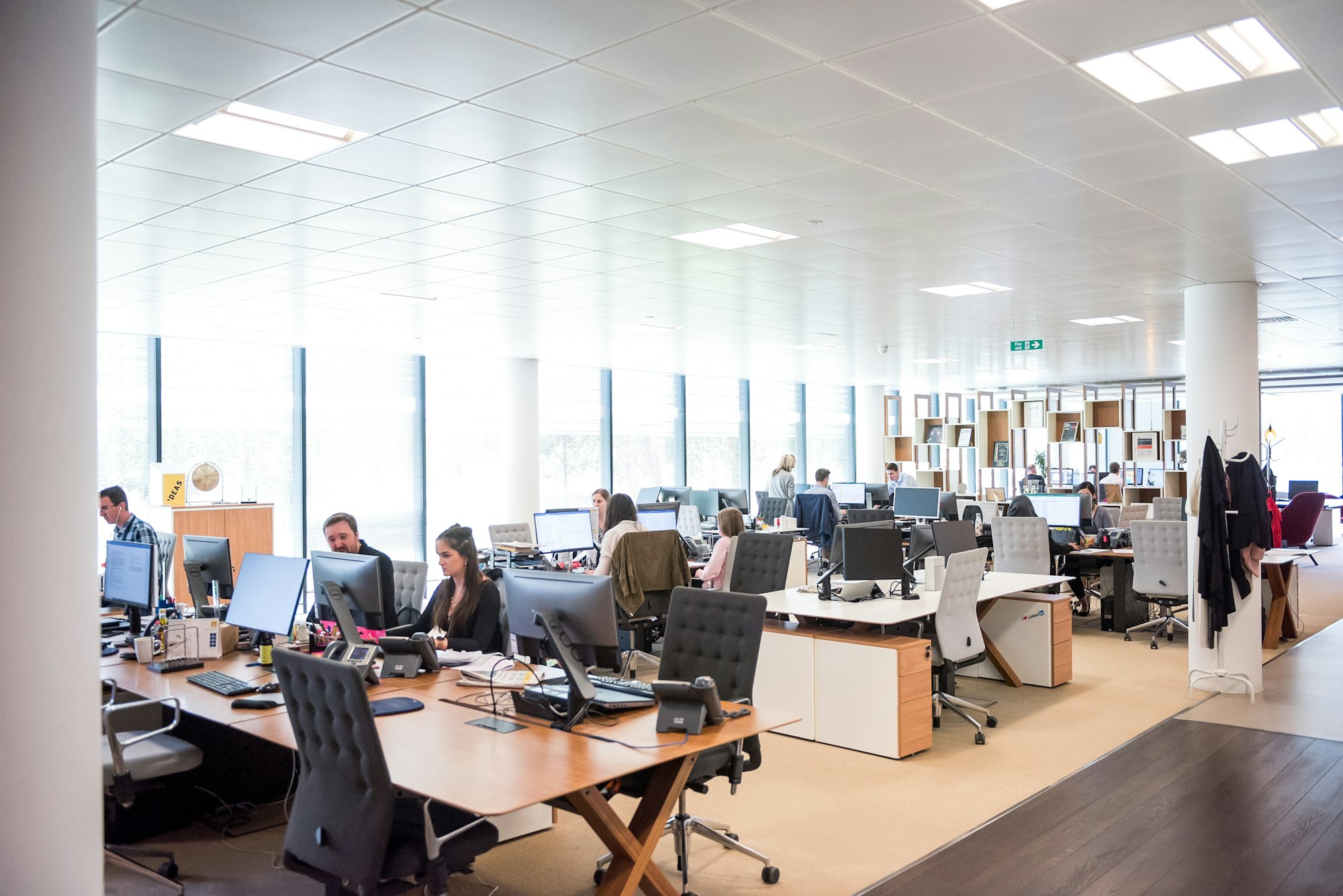Sabbatical report, week 5: On workspaces, collaboration, and isolation
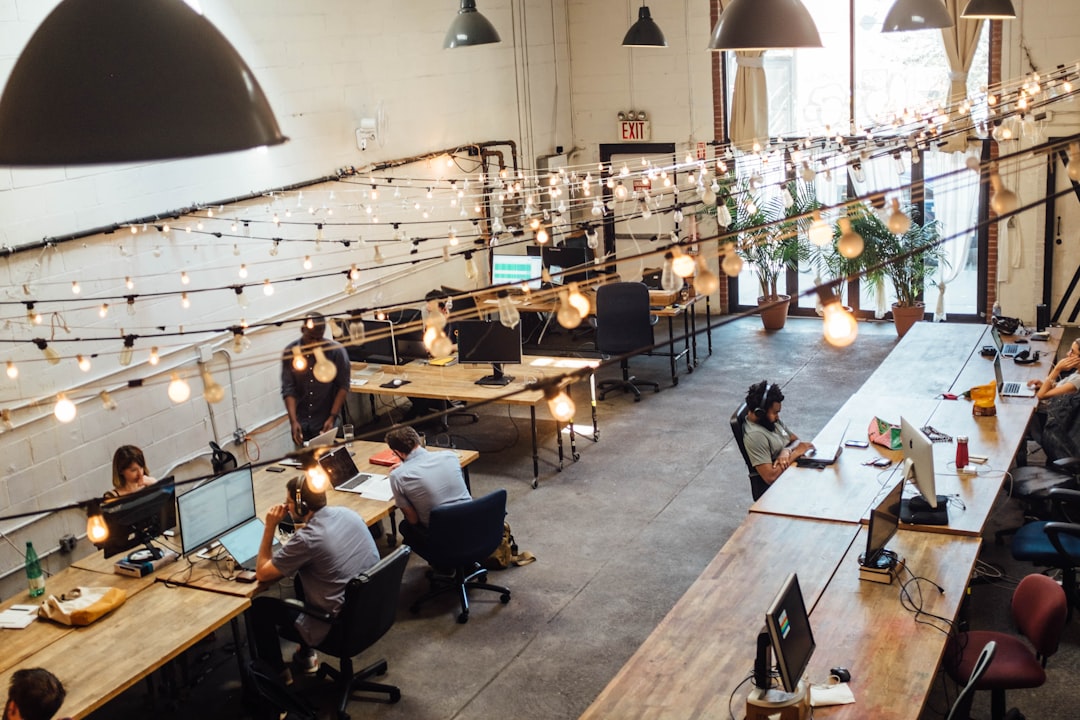
As of last week, I officially completed an entire month "on the job" at Steelcase. I've completed most of the onboarding process for getting assimilated into the company (which sounds vaguely creepy, doesn't it?) and I'm now in a position not only to start contributing to what Steelcase EDU does, I'm also able to step back and observe the culture of this place and compare it against what I've seen at my university job.
One of my stated objectives in this sabbatical is to study the organizational culture, leadership practices, and approaches to creativity and innovation that are evident at Steelcase, and to think about how to import the best of what I see back into higher education once I return next fall. One aspect of my environment that I've been thinking about lately is collaboration, and how that's built into what Steelcase does.
It's fair to say that Steelcase runs on collaboration. I am not always collaborating with other people (in fact most of the time I'm here so far, I'm working by myself to write or do research) but collaboration is always happening. It's the default setting for every person who works here. You can see it in the physical infrastructure, among other things. For example, here's a bad photo of the general area where I work:
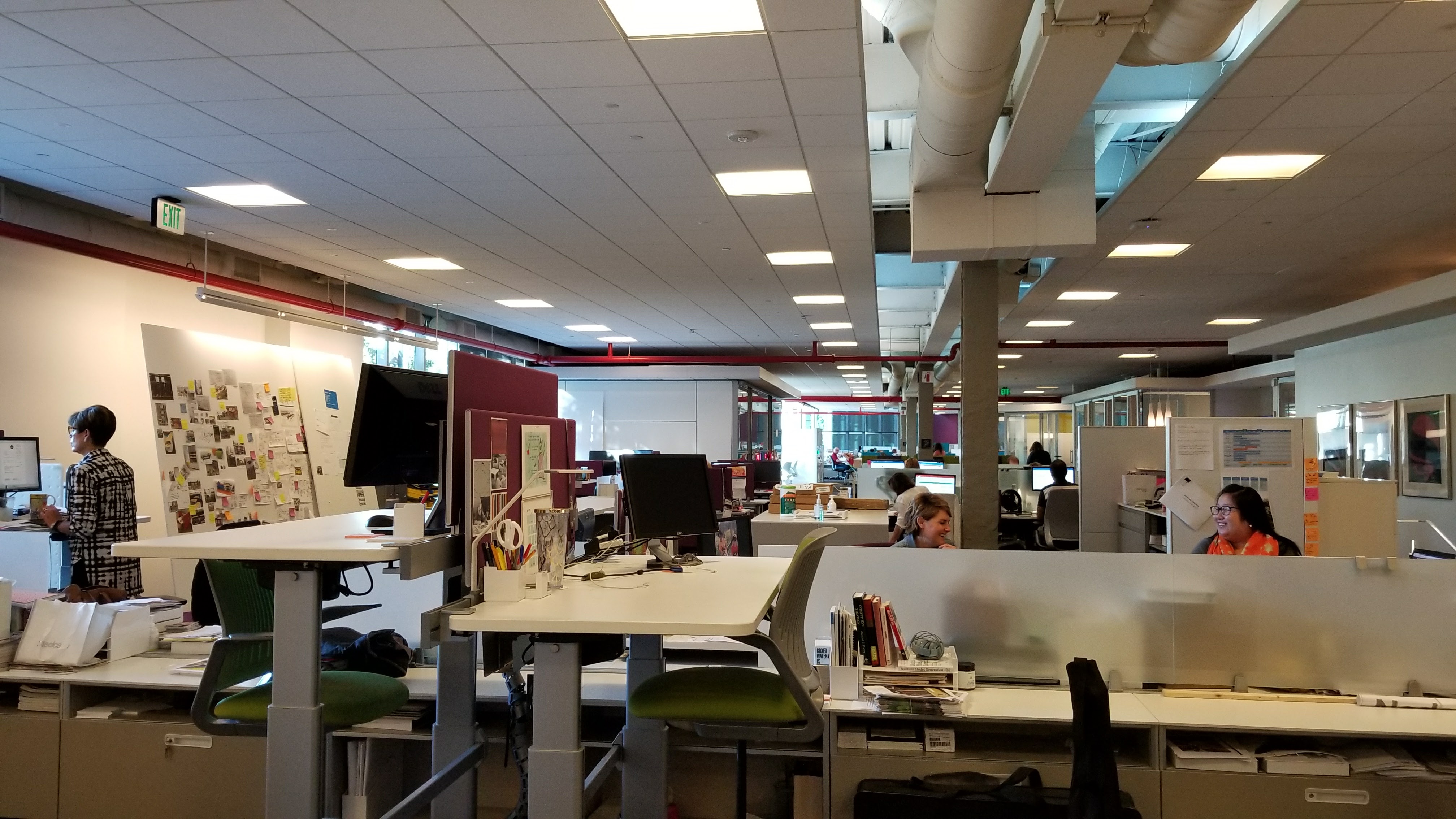
The standing desk in the foreground on the left is "my" desk, although it's not actually mine --- I share it with one of the product managers in the EDU group. Here's a photo of where I was sitting when I took the previous photo:
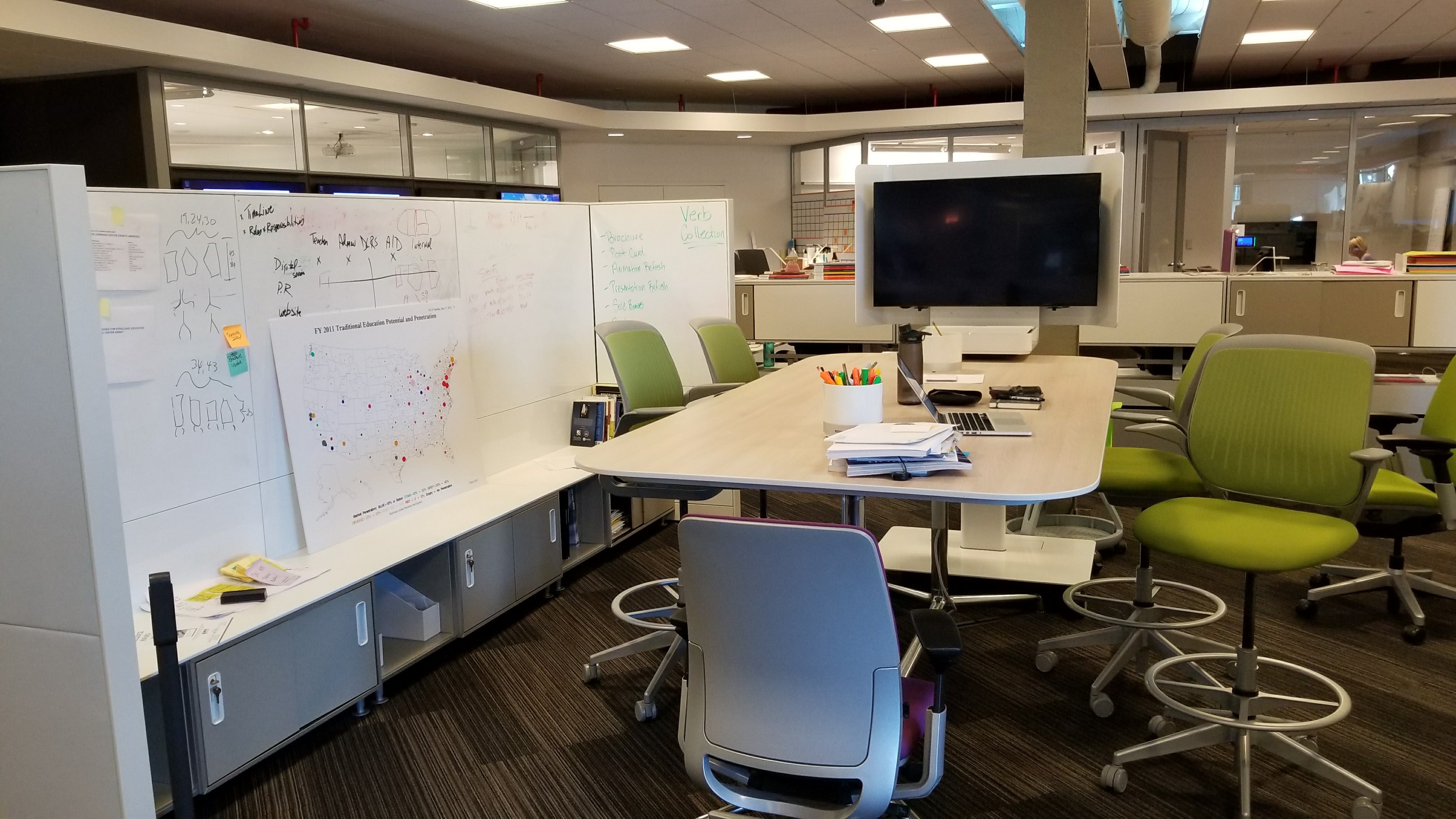
This is a cozy, semi-private (at least walled-off) group work area for 6--8 people, with a monitor and whiteboard half-walls. And here's a better shot of just beyond that area:
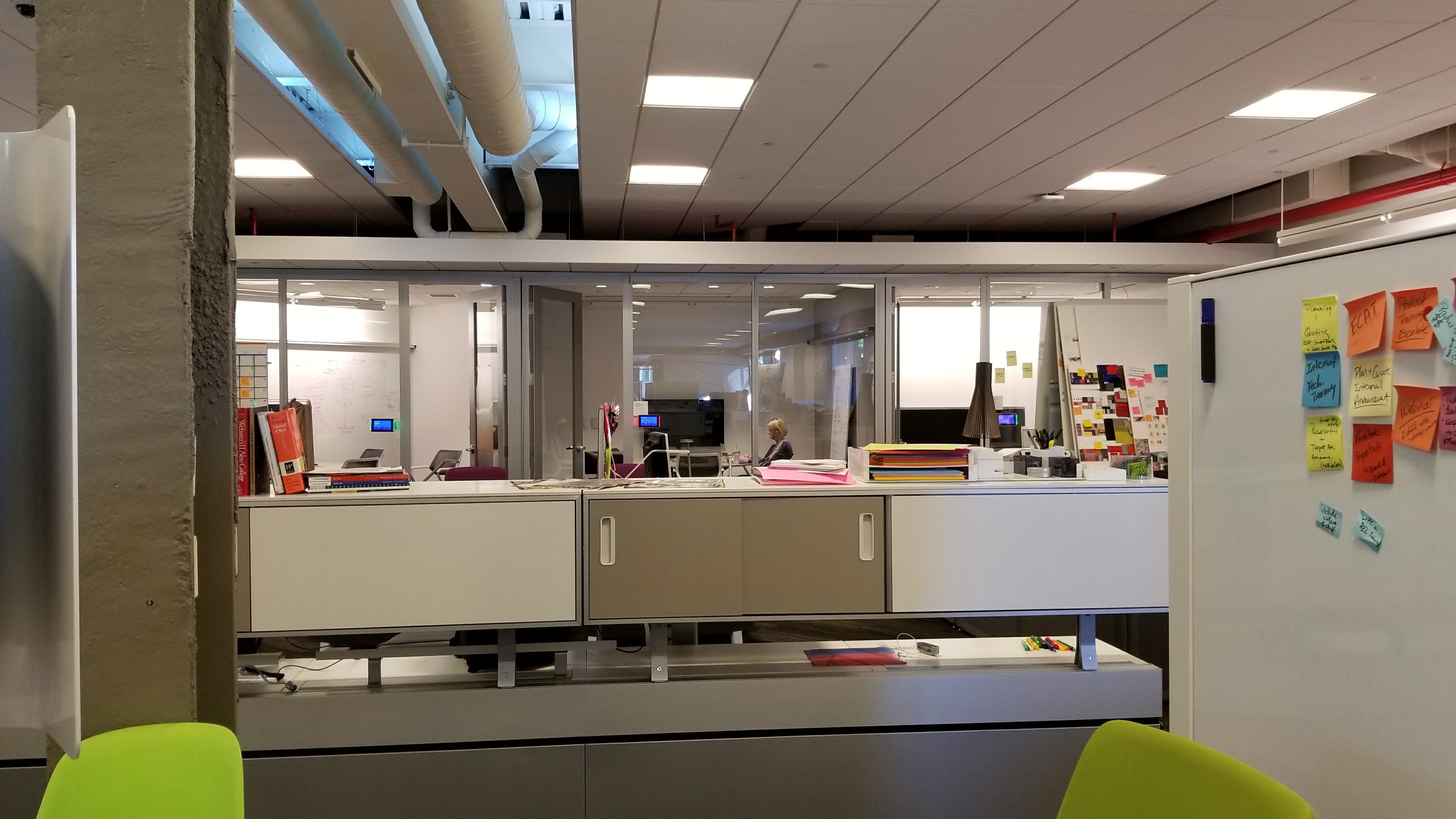
It's another work area, with a few desks but also individual seats, an area with a sofa in front of a floor-to-ceiling whiteboard, and at the very back (which you can see here) are three rooms for 3--4 people. Those rooms have heavy glass walls, so they're semi-private and soundproof, but at the same time you're visible to the rest of the area.
The entire Learning and Innovation Center building where I work is like this, a combination of public and private spaces of varying sizes. It's not really an "open office" concept which used to be all the rage in business but now has more skeptics than proponents. In this sort of space setup, privacy is attainable, but accessibility and collaboration are the default.
Collaboration also shows up in other ways. There's a big focus here on person-to-person contact. That might sound like corporate-speak for "meetings" and many times this contact does manifest itself as meetings. But it's more than that; throughout my work day, I'm coming into face-to-face contact with people in and out of my group in both formal and informal settings: People who come to me who want to pick my brain for 10 minutes on some idea they had, or conversely people whose brains I pick about some aspect of a project that's going on. Sometimes these coalesce into formal meetings; for example we have a one-hour staff meeting on Monday mornings. But mostly, the way work gets done here is relationship-based, through person-to-person interaction and combining the ideas and strengths of different people.
And when I say "different" I mean different. There's a real diversity of thought in the area where I work. In the first photo above, in the foreground, there's our administrative assistant, an interior designer, and a marketing specialist all next to each other, and all next to me. Our general manager sits behind me at a desk just like mine. Within a 10-foot radius are more interior designers, a financial analyst, and a sales leader. So I am interacting very frequently with people who have different viewpoints and skills than I have --- what a concept.
I think Steelcase also does a good job of leveraging technology to make collaboration work. Our formal meetings often consist of 75% of the group in the room together and the other 25% Skyping in, from locations in Indiana, Texas, North Carolina, sometimes from indeterminate points on the road or from other countries, or just from someone's house locally because they had a sick kid that day. The technology doesn't replace the face-to-face nor vice versa --- they work together, much like we people work together.
Comparing this to how collaboration works in higher education, at least how I've experienced it in my career at three different colleges and by visiting many others, the differences are pretty striking.
Faculty office space, for instance. I've thought a lot about my faculty office space since I've been here and what strikes me is that faculty offices are designed around the opposite assumptions that Steelcase workspaces are designed: For many faculty offices, accessibility and collaboration are attainable, but privacy is the default. You might even say that isolation is the default. We make offices with heavy doors, little to no visibility from the outside in, segregated from the rest of the university life, including our own colleagues. The office is not set up as a learning space but as a personal space.
This issue about personal space is, I'm convinced, a big reason why more students don't come to our offices. I wonder if we've thought much about the psychological barrier that a student has to overcome to visit a faculty member in their office. Once a faculty office is established as that faculty member's personal space --- their right to isolation --- a student has to violate, literally, your personal space to visit. An office visit then generates the same fight-or-flight response that would happen if you found someone in an almost-empty bus and sat down next to them rather than in one of the many other open seats. Students, being people, have a natural aversion to violating someone else's personal space, and so when it comes to fight or flight, most students will choose "flight".
Our workspaces in higher education also can inhibit collaboration with colleagues. I love my colleagues and I love where I work, but our office layout in my department is a perfect case in point. There are around 30 faculty members in my department in four separate archipelagoes of offices: There's an L-shaped pair of hallways that provide two of those islands, another island on another hallway, and a fourth that is separated from the other three by physical distance as well as a door to the hallway that remains shut most of the time. There are colleagues in my department with whom I have close to zero interaction all year except for department meetings, just because I am not around them. And that's to say nothing about collaboration outside my department, which is all but impossible outside of a formal setting like a planned meeting.
Even when I taught in smaller schools with only 50-60 faculty across the entire institution, this was the case. There were institutional silos set up, exacerbated by physical separation across buildings and hallways, and finally down to the layout of offices. Again. accessibility and collaboration are attainable, but privacy/isolation is the default.
You can't always be collaborating in academic work. Sometimes you simply need to get your head down and get work done without the intrusion of others. At the same time, our default to privacy hurts us in higher education. I look around me here at Steelcase and think about how awesome the collaborations --- planned and unplanned --- have been this week and I wonder what we're missing out on in higher education by not striving for the same thing.
It might be the effects of working in a place like Steelcase for five weeks, but I think a change in the way we conceive of our workspaces can go a long way toward better collaboration in higher education. I do not propose that we all work in an open office plan. But I do think that more openness, more accessibility to students and to each other, and a de-emphasis on personal space could go a long way.

